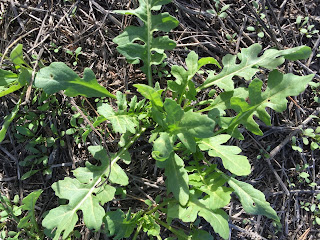 |
| London rocket (Sisymbrium irio) (Photo: N. Goldberg, NMSU) |
 |
Beet Curly Top Virus on chile peppers
(Photo: N. Goldberg, NMSU) |
A wet fall, especially rainfall in October, helps to germinate winter annual weeds. Some of these weeds, particularly those in the mustard family, such as London rocket (
Sisymbrium irio), provide an excellent overwintering habitat for the curly top insect vector, the beet leafhopper (
Circulifer tenellus). Some of these weeds are also asymptomatic hosts for the Beet Curly Top Virus. Studies at New Mexico State University have shown that severe outbreaks of Beet Curly Top Virus occur in years with excessive rain the preceding October. Within the last couple of weeks, huge populations of London rocket have developed in Dona Ana County (and probably most other counties in New Mexico). This weed can germinate in high numbers such that it appears like a ground cover. A significant effort to eliminate these weeds now, while they are small, should help to reduce the overwintering sites for the beet leafhopper and subsequently reduce the potential for Beet Curly Top Virus next year.
 |
London rocket (Sisymbrium irio) in an empty lot
(Photo: N. Goldberg, NMSU) |
 |
A dense population of London rocket growing along
a roadway (Photo: N. Goldberg, NMSU) |
 |
London rocket in an alfalfa field in the middle of winter
(Photo: N. Goldberg, NMSU) |
 |
A beet leafhopper (Circulifer tenellus), the insect vector of the
Beet Curly Top Virus (Photo: J. Shaughney, NMSU) |
 |
Beet Curly Top Virus on bean (upper left), pumpkin (upper right),
spinach (lower left), and tomato (lower right)
(photos: N. Goldberg and J. French, NMSU) |







